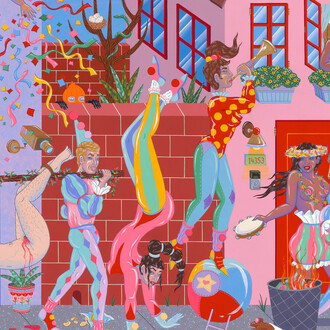Garis & Hahn is pleased to present Neo-American Transcendental, an exhibition of recent mixed-media work and a continuation of previous series from Michael Maxwell. For this solo show, Maxwell presents 12 large-scale paintings that blend digital imagery with natural mark-making, which result in heavily-layered assemblages that incorporate the artist’s Neo-expressionist and Abstract Expressionist influences.
The new paintings build upon ideas and themes that Maxwell has introduced in three previous series—“Phosphenes”, “Li,” and “Orgone”—and introduces a new series, “Landscapes.” Beginning with a pattern constructed digitally, the artist adds a range of organic and inorganic materials (oil paint, beeswax, clay, quartz crystal, among others) to the printed base layer. There is “tension” between the programmed marks and the paint strokes as he strives to make sure every element is in balance with one another. A painting’s physicality–how it exists and occupies space–is central to the artist’s practice.
In the “Phosphenes” series, Maxwell creates abstract patterns that mimic the neurological effect of visualizing light when eyes are closed; the “Li” series references the Chinese concept of pattern found in nature; the “Orgone” series combines organic and inorganic materials toward generation of a “life force.” For his newest series, “Landscapes” he combines the painting elements of his past series with photographs of nature taken near his studio in the Catskill Mountains in New York. This synthesis of old and new influences in “Landscapes” references the generation and replication of energy and its effect on the human body.
Maxwell draws from disparate sources for the thematic basis of his practice. While recent investigations have brought him to the history of landscape painting, pastoralism, American Transcendentalists, and the Hudson River School, his work has been shaped by writings and research into the unconscious, meditative states, and neuroscience, in addition to philosophy and linguistics. The brain-body connection is paramount to the viewer’s understanding, perception, and awareness of art.
















